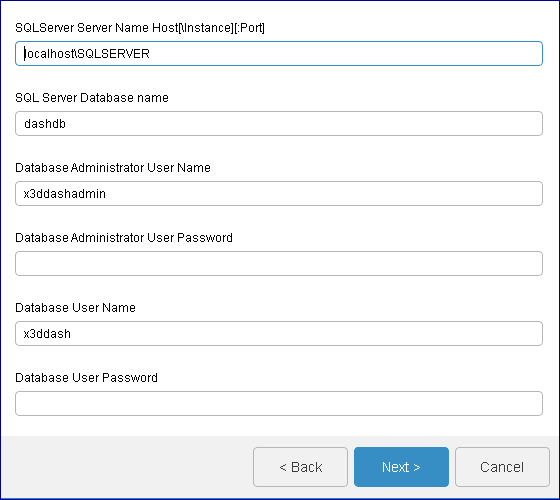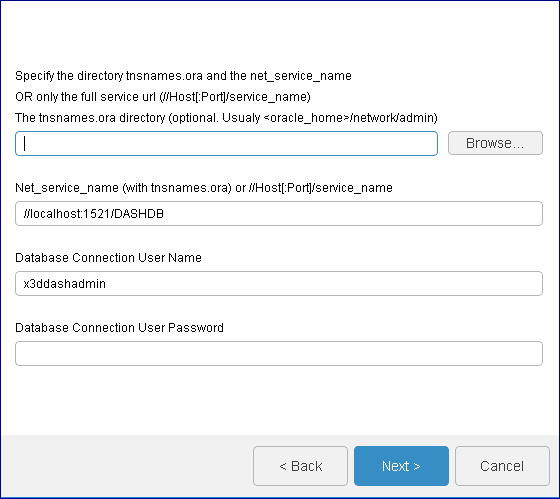Installing 3DDashboard | |||
| |||
-
Procure the media for your operating system, and prepare to
install the software as explained in this section.
The name of the installation media is:
3DDashboard-V6R2022x.Windows64.zipon Windows3DDashboard-V6R2022x.Linux64.tar.gzon Linux
-
Untar/unzip the media to create the following directory:
3DDashboard-V6R2022x.Windows64on Windows3DDashboard-V6R2022x.Linux64on Linux.
-
Change to the distribution directory.
The directory is:
3DDashboard-V6R2022x.Windows64/1on Windows3DDashboard-V6RR2022x.Linux64/1on Linux
then start the installation as follows:
- Windows: double-click setup.exe
- Linux: ./StartGUI.sh for the GUI, or ./StartTUI.sh
The installation procedure then starts:

Note: The dialog boxes are the same on both Windows and Linux.Click Next.
-
Specify the installation directory.

The default values are:
C:\DassaultSystemes\R2022x\3DDashboardon Windows (remove any spaces before you confirm)/usr/DassaultSystemes/R2022x/3DDashboardon Linux.
Note: The installation path cannot contain any space characters.If you accept the default destination folder, click Next, or click on Browse... and select the destination folder. The folder you choose must be empty. You can also specify a new folder.
Click Next.
-
Specify if you want to install embedded Java.

The This install is for Testing or Demonstration purposes only (it uses an embedded JDK). check box is not selected by default.
If you select the check box, the embedded JDK will be installed in:
C:\DassaultSystemes\R2022x\3DDashboard\win_b64\code\serverjreon Windows/usr/DassaultSystemes/R2022x/3DDashboard/linux_a64/code/serverjreon Linux.
Choosing embedded Java automatically implies also choosing embedded TomEE+ .
Click Next.
-
If you did not check the This install is for Testing or
Demonstration purposes only (it uses an embedded JDK). check
box, you must specify the Java Home path.

This is the location of your Java Development Kit (JDK).
On Windows, the Java location will be automatically detected.
If you use a local Certificate Authority, register your certificates in this Java store using the
keytoolutility.Click Next.
-
If you decided not to install embedded Java earlier, you will be prompted to
specify whether you want to install the TomEE+ application server or not.

Make sure that you have an application server to install the service.
Check the This install is for Testing or Demonstration purposes only (it uses an embedded TomEE+) option if you want to install the TomEE+ application server integrated in the media. It will be installed in:
- <3DDashboardInstallPath>\win_b64\code\tomee on Windows
- <3DDashboardInstallPath>/linux_a64/code/tomee on Linux
On Windows, the 3DEXPERIENCE R2022x 3DDashboard TomEE+ service is created and started.
To start and stop embedded TomEE+ on Linux, launch:
<3DDashboardInstallPath>/linux_a64/code/tomee/bin/startup.sh
<3DDashboardInstallPath>/linux_a64/code/tomee/bin/shutdown.sh -force
Click Next.
-
If you decided to use external TomEE+:
-
Make sure that you have an application server to install the
service.
- External Apache TomEE+ directory: <externalTomEEInstallPath>
- For more information see Installation and Setup: Install: 3DEXPERIENCE Platform: Installing 3DEXPERIENCE Platform Services for the First Time: Installing Services One-by-One: 3DDashboard: Operations
-
Specify the path of your existing TomEE+ installation.

- Click Next.
-
Make sure that you have an application server to install the
service.
-
If you decided to install the embedded TomEE+, specify the TomEE+ connection
port number.

Choose a listening port number for TomEE to listen for HTTP requests. The default port is 8080. The next available port will be used for shutdown.
If the port 8080 is busy, the installer will display the next available free port. If you specify a custom port value, the installer will check if it is available.
Click Next.
An information box containing the following message appears:
Chosen Apache TomEE+ connection port 8082 Automatically fixed TomEE+ shutdown port 8083 (first free following port)
Click OK.
-
If you are using embedded Java, specify the certificate location.

This directory contains the certificates to import into the JVM used by TomEE+.
The default is:
C:\Windows\Temp\DassaultSystemeson Windows/tmp/DassaultSystemeson Linux.
This location is used to import certificates. If it contains valid certificates, the 3DDashboard installer will import them in the embedded or external JDK using the keytool utility.
If you leave the path empty, you can import the certificates manually later as a post-installation step. For more information see Installation and Setup: Install: 3DEXPERIENCE Platform: Reconfiguring the 3DEXPERIENCE Platform Installation.
Click the Next.
-
Select the database type you are using and specify
the database connection parameters.

-
On Windows and Linux, if you selected SQL Server, enter the SQL Server connection parameters:

- SQL Server Server Name: Host[\Instance][:Port]
- SQL Server database hostname. The default is
localhost\SQLSERVER.Note:- 3DDashboard uses a TCP/IP connection to SQL Server, so the default 1433 port (or another) needs to be configured using SQL Server Configuration Manager.
- Indicate additional database connection properties required to support encryption for
instance:
localhost\SQLSERVER;encrypt=true;sslProtocol=TLSv1.2
Make sure the SQL Server certificate is imported in the Java keystore of the service.
- SQL Server Database name
- Database schema name you must already have created as explained in Create Databases and Database Users. The default is
dashdb. It should be empty in the case of a fresh install from scratch. - Database Administrator User Name
- Database Administrator user name. The default is
x3ddashadmin. You must have created this user already with the appropriate permissions to the above database schema, as explained in Create Databases and Database Users. - Database Administrator User Password
- Database Administrator user password.
- Database User Name
- Database user name, which you created already as explained in Create Databases and Database Users. The default is
x3ddash. - Database User Password
- Database user password.
-
On Windows and Linux, if you selected Oracle, enter the Oracle connection parameters:

- Specify the directory
tnsnames.ora and the
Net service nameOR only the full service URL (//Host[:Port]/service_name) -
Specify the directory containing the tnsnames.ora file. It is usually located in
<Oracle_Home>/network/admin.Note: Use the tnsnames.ora file method for specifying database name details. - Net Service Name (with tnsnames.ora) or //Host[:Port]/service_name
-
Database (service) name which you created already as explained in Create Databases and Database Users. There are two options:
- If you did NOT not specify the
tnsnames.ora file path, specify the
name in the following format:
//localhost:1521/dashdb. - If you DID specify the tnsnames.ora file path, specify just the
name:
dashdb
- If you did NOT not specify the
tnsnames.ora file path, specify the
name in the following format:
- Database connection user name
- Database user name that you created already as explained in Create Databases and Database Users. The default is
x3ddashadmin. - Database connection user password
- Database user password.
- Specify the directory
tnsnames.ora and the
Click Next.
-
-
Specify the service endpoints (enter the URL of the different
services).
Note: Do not use uppercase characters in the URLs (standard form specified in RFC3986)

Before you do so, check the following:
- the URLs must contain Fully Qualified Domain Names (FQDN)
- the URLs must start with
https://(and not ftp or other) - 3DPassport must have a rootURI if you install all the services on the same computer
- 3DSpace (3DCompass) has a root URI
- If you install all the services on the same computer, the ports must be different.
If you are installing the services on the same computer, each service requires a different port number.
Sample URLs (if the services are installed on different computers) are:
-
3DPassport
service URL: for example
https://3dpassport.mydomain:443/3dpassport: this must be the service URL you already created - 3DDashboard
service URL: for example
https://3ddashboard.mydomain:443/3ddashboard - 3DCompass
service URL: for example
https://3dspace.mydomain:443/3dspace - 6WTags
service URL: for example
https://3dspace.mydomain:443/3dspace
The license control service URL (default is:
https://dsls.mydomain:4085) will only appear if the DSLicSrv.txt file is not present in C:\ProgramData\DassaultSystemes\Licenses (Windows) or /var/DassaultSystemes/Licenses (Linux). The DSLicSrv.txt file will then be created in the correct location, and will contain, for example:dsls.mydomain:4085. The user performing the installation must have write access to the directory containing the file.Click Next.
-
Configure the mail server.

Enter the following information:
Mail server name: the default islocalhost; in this case, local system should be configured to be capable of sending emails with enterprise-specific configurationMail sender name: the email address of the sender of emails sent by the application; the default isadmin_platform@3ddashboard.mydomainbut you can use another email. The mail sender name is used for password recovery (not available for user passwords if connected to enterprise SSO/LDAP), and notifications on security (if activated).
Click Next.
-
Specify the parameters for loading trusted widgets, and specify the requested
paths.

Domain to use for loading external Widgets (untrusted widgets): Enter here another hostname that also references the application's server. This hostname will isolate untrusted widgets. This must be a valid domain with a valid SSL certificate (wildcards are not supported). For example:untrusted.3ddashboard.3dexperience.mycompany.comAllow WebAPI for following domains: List of URL regular expressions that are not to be reached through HTTP proxy, if any( .* = all). Used by widgets to fetch data from another service. Defaults to.*For example:
(.*\.mycompany\.com.*) (.*\.mycompany2\.com.*)
and:
yourdomain\.com|www\.yahoo\.com|news\.google\.com
Shared Directory: Specify the shared directory name to be used for storing data. The default is:C:\DassaultSystemes\3DDashboardDataon Windows and/share/DassaultSystemes/3DDashboardDataon Linux.Use a mounted path for the shared directory. This method is particularly useful when large amounts of data need to be saved, and also facilitates management of a load balanced environment.
Click Next.
-
Review your installation choices, then click on Install
.

You can consult the installation logs here:
- <3DDashboardInstallPath>\InstallData\log on Windows
- <3DDashboardInstallPath>/InstallData/log on Linux.
Installation log files are prefixed by the installation media name.
Also consider the following logs for debugging or analyzing:
- Apache Httpd: defaults to <ApacheInstallDir>\logs\* on Windows, <ApacheInstallDir>/logs/* on Linux
- embedded TomEE default log directory:
<3DDashboardInstallPath>\win_b64\code\tomee\logs on Windows
<3DDashboardInstallPath>/linux_a64/code/tomee/logs on Linux
- external Apache TomEE default log directory:
<externalTomEEInstallPath>\logs on Windows
<externalTomEEInstallPath>/logs on Linux.
- 3DDashboard logs:
<3DDashboardInstallPath>\logs\uwp on Windows
<3DDashboardInstallPath>/logs/uwp on Linux.